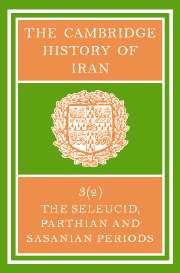Book contents
- Frontmatter
- PART 5 INSTITUTIONS
- PART 6 RELIGIOUS HISTORY
- PART 7 ART HISTORY
- PART 8 LANGUAGES AND LITERATURE
- 31 PARTHIAN WRITINGS AND LITERATURE
- 32(a) ZOROASTRIAN PAHLAVĪ WRITINGS
- (b) THE MANICHAEAN MIDDLE PERSIAN WRITINGS
- (c) MIDDLE PERSIAN INSCRIPTIONS
- 33 SOGDIAN LANGUAGE AND LITERATURE
- 34 KHOTANESE SAKA LITERATURE
- 35 KHWARAZMIAN LANGUAGE AND LITERATURE
- 36 BACTRIAN LITERATURE
- PART 9 BIBLIOGRAPHY
- Bibliography
- Index
- Index of Greek words
- References
36 - BACTRIAN LITERATURE
from PART 8 - LANGUAGES AND LITERATURE
Published online by Cambridge University Press: 28 March 2008
- Frontmatter
- PART 5 INSTITUTIONS
- PART 6 RELIGIOUS HISTORY
- PART 7 ART HISTORY
- PART 8 LANGUAGES AND LITERATURE
- 31 PARTHIAN WRITINGS AND LITERATURE
- 32(a) ZOROASTRIAN PAHLAVĪ WRITINGS
- (b) THE MANICHAEAN MIDDLE PERSIAN WRITINGS
- (c) MIDDLE PERSIAN INSCRIPTIONS
- 33 SOGDIAN LANGUAGE AND LITERATURE
- 34 KHOTANESE SAKA LITERATURE
- 35 KHWARAZMIAN LANGUAGE AND LITERATURE
- 36 BACTRIAN LITERATURE
- PART 9 BIBLIOGRAPHY
- Bibliography
- Index
- Index of Greek words
- References
Summary
The study of Bactrian literature, under this name, has only recently emerged from adolescence. There is little text-material, and even it is largely elusive. On much of it no opinion has as yet been expressed that would help to place it within the pan-Iranian context of the present volume. Inevitably, therefore, many views here offered are personal. This is true especially in respect of the main Bactrian text, the Nokonzok inscription, on which the present writer is alone in print with an overall assessment.
The notion that Bactrian was the language of the Avesta had rightly fallen into discredit by the end of the 19th century. This left the term inapplicable to any known language until 1960, when W. B. Henning identified as Bactrian the language of a Greek-letter inscription discovered three years earlier on Bactrian soil by the French Archaeological Delegation in Afghanistan. The inscription was carved in the 2nd century a.d. into a beautiful monolith placed at the entrance of the temple-acropolis of Baghlan at Surkh Kotal, situated at some 25 miles south-west of the present-day town of Baghlan, and approximately 100 miles south-east of where the capital city of Bactra had once stood. The inscription, which consists of some 180 words supplying a vocabulary of about 100, deserves to be named after its main protagonist, Nokonzok, described in it as a high dignitary holding the office of “Lord of the Marches” (kanārang) in the year 31, which year fell early in the reign of the Kushān emperor Huviška.
- Type
- Chapter
- Information
- The Cambridge History of IranSeleucid Parthian, pp. 1250 - 1258Publisher: Cambridge University PressPrint publication year: 1983



